Lean and Agile Manufacturing: Principles, Applications, and Examples
VerifiedAdded on 2023/01/19
|11
|2213
|42
Report
AI Summary
This report provides a comprehensive evaluation of lean and agile manufacturing principles, contrasting their approaches and exploring their applications in both manufacturing and service sectors. It begins by defining lean manufacturing as a waste-elimination process focused on delivering high-quality products at lower costs, while agile manufacturing prioritizes rapid response to changing customer demands. The report discusses the core principles of each methodology, highlighting lean's emphasis on waste reduction and continuous improvement, and agile's focus on flexibility and adaptability. It then examines the implementation of lean principles in a manufacturing environment, emphasizing the importance of management commitment and employee motivation, and in a service environment, where lean practices can improve financial benefits and customer satisfaction. The report further illustrates these concepts by citing Toyota's successful implementation of lean production and Kenyatta Hospital's use of Six Sigma to improve healthcare services. In conclusion, the report acknowledges the increasing prominence of lean practices in manufacturing and the potential for long-term effects, advocating for continuous improvement and capability development for sustainable implementation.
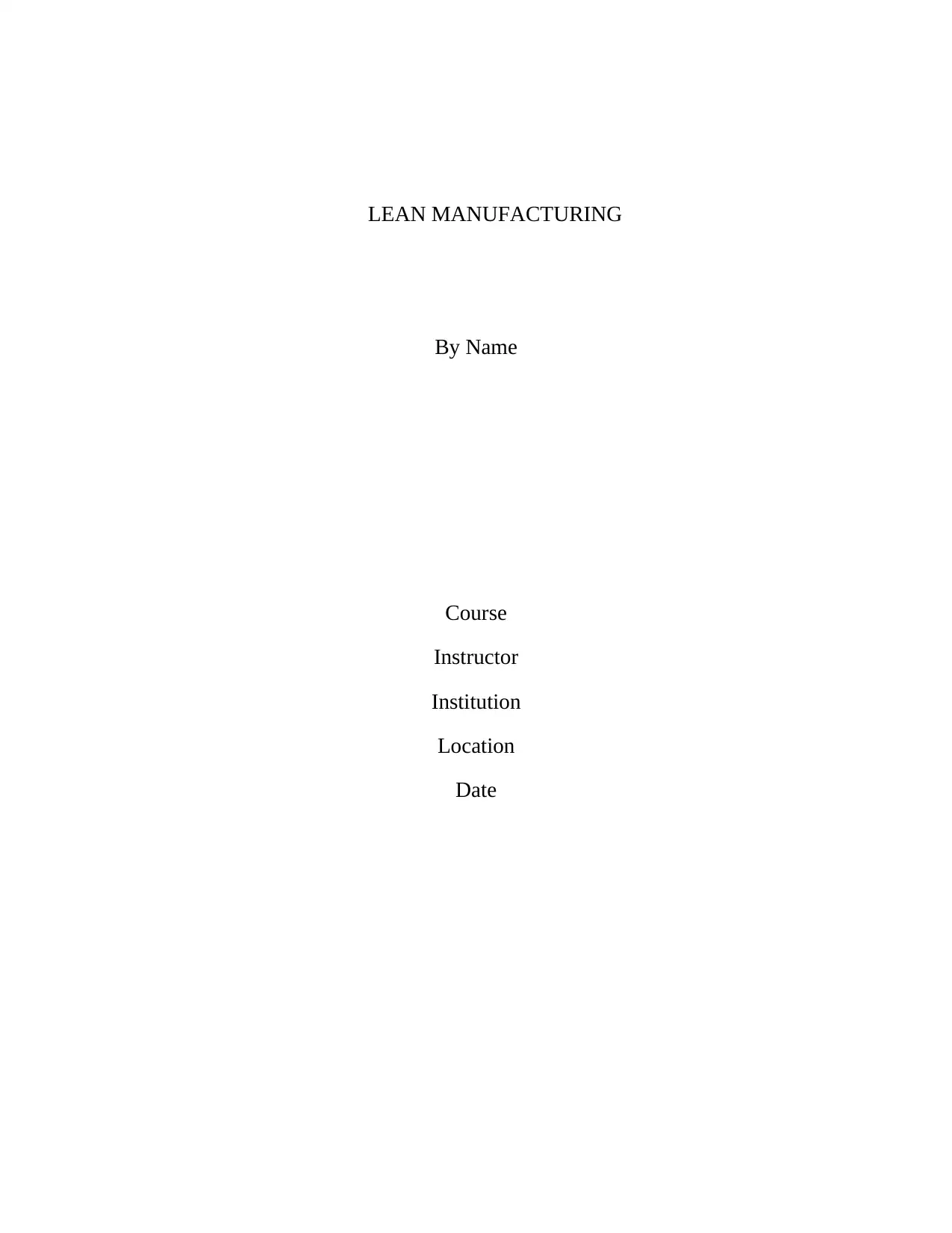
LEAN MANUFACTURING
By Name
Course
Instructor
Institution
Location
Date
By Name
Course
Instructor
Institution
Location
Date
Paraphrase This Document
Need a fresh take? Get an instant paraphrase of this document with our AI Paraphraser
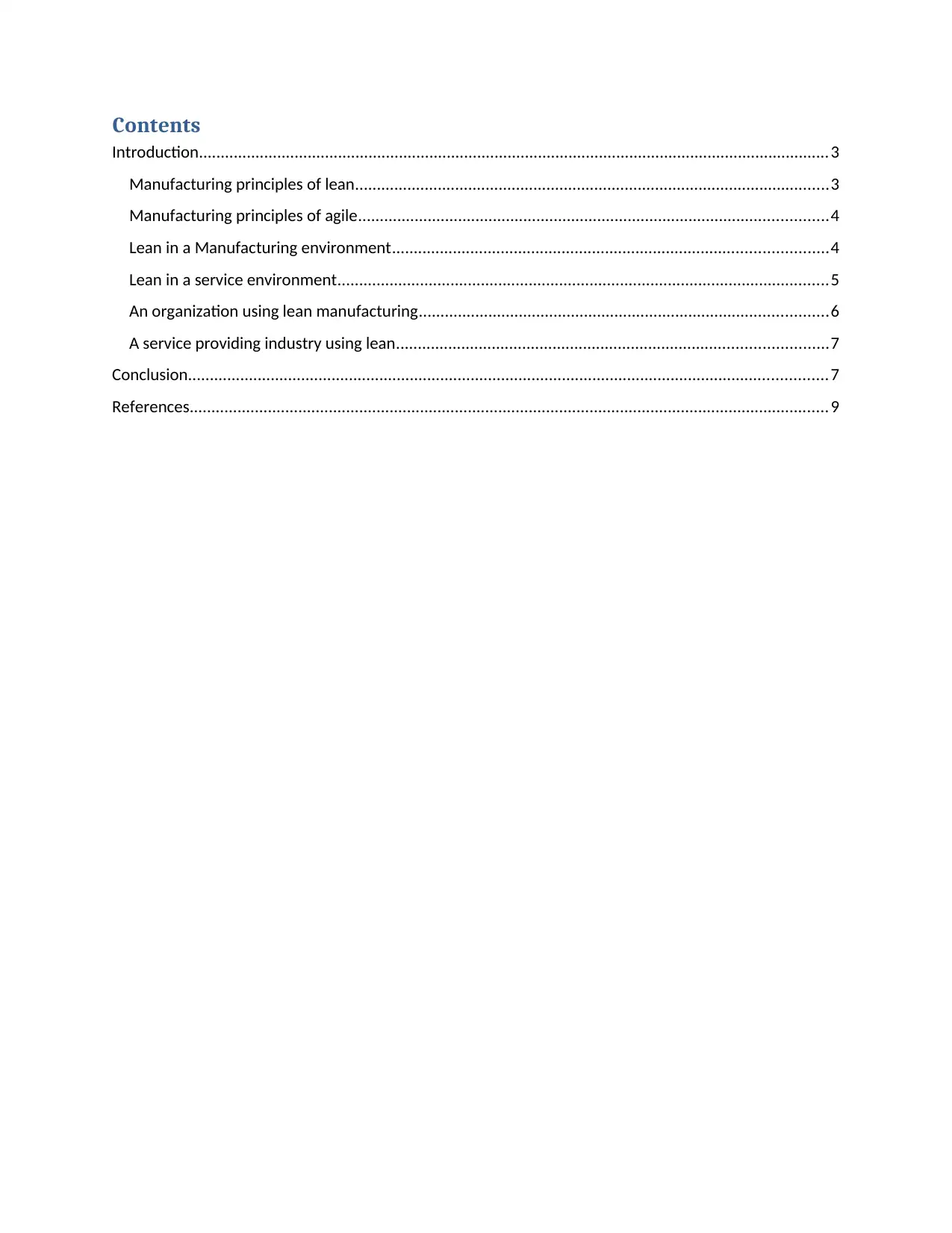
Contents
Introduction.................................................................................................................................................3
Manufacturing principles of lean.............................................................................................................3
Manufacturing principles of agile............................................................................................................4
Lean in a Manufacturing environment....................................................................................................4
Lean in a service environment.................................................................................................................5
An organization using lean manufacturing..............................................................................................6
A service providing industry using lean...................................................................................................7
Conclusion...................................................................................................................................................7
References...................................................................................................................................................9
Introduction.................................................................................................................................................3
Manufacturing principles of lean.............................................................................................................3
Manufacturing principles of agile............................................................................................................4
Lean in a Manufacturing environment....................................................................................................4
Lean in a service environment.................................................................................................................5
An organization using lean manufacturing..............................................................................................6
A service providing industry using lean...................................................................................................7
Conclusion...................................................................................................................................................7
References...................................................................................................................................................9
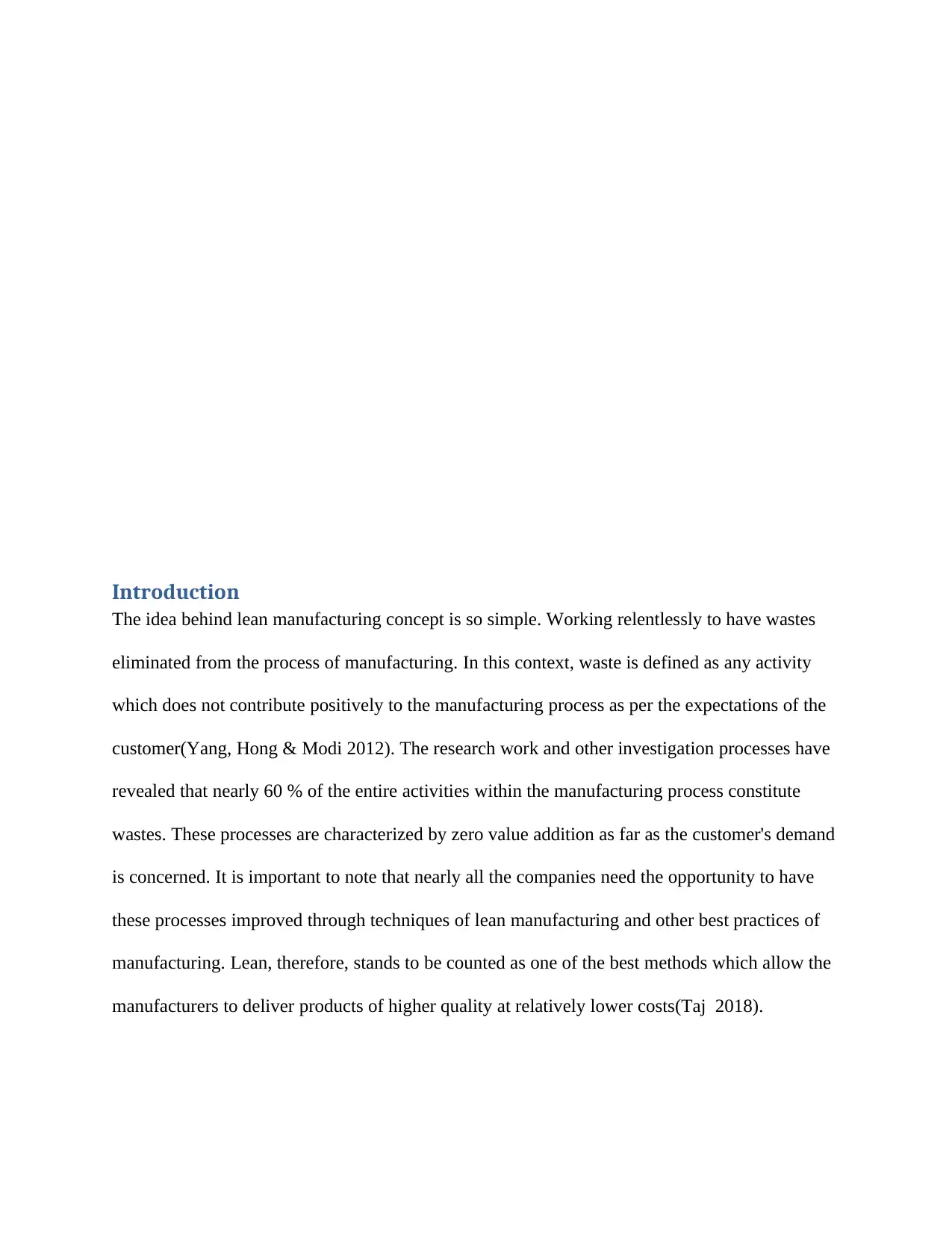
Introduction
The idea behind lean manufacturing concept is so simple. Working relentlessly to have wastes
eliminated from the process of manufacturing. In this context, waste is defined as any activity
which does not contribute positively to the manufacturing process as per the expectations of the
customer(Yang, Hong & Modi 2012). The research work and other investigation processes have
revealed that nearly 60 % of the entire activities within the manufacturing process constitute
wastes. These processes are characterized by zero value addition as far as the customer's demand
is concerned. It is important to note that nearly all the companies need the opportunity to have
these processes improved through techniques of lean manufacturing and other best practices of
manufacturing. Lean, therefore, stands to be counted as one of the best methods which allow the
manufacturers to deliver products of higher quality at relatively lower costs(Taj 2018).
The idea behind lean manufacturing concept is so simple. Working relentlessly to have wastes
eliminated from the process of manufacturing. In this context, waste is defined as any activity
which does not contribute positively to the manufacturing process as per the expectations of the
customer(Yang, Hong & Modi 2012). The research work and other investigation processes have
revealed that nearly 60 % of the entire activities within the manufacturing process constitute
wastes. These processes are characterized by zero value addition as far as the customer's demand
is concerned. It is important to note that nearly all the companies need the opportunity to have
these processes improved through techniques of lean manufacturing and other best practices of
manufacturing. Lean, therefore, stands to be counted as one of the best methods which allow the
manufacturers to deliver products of higher quality at relatively lower costs(Taj 2018).
⊘ This is a preview!⊘
Do you want full access?
Subscribe today to unlock all pages.

Trusted by 1+ million students worldwide
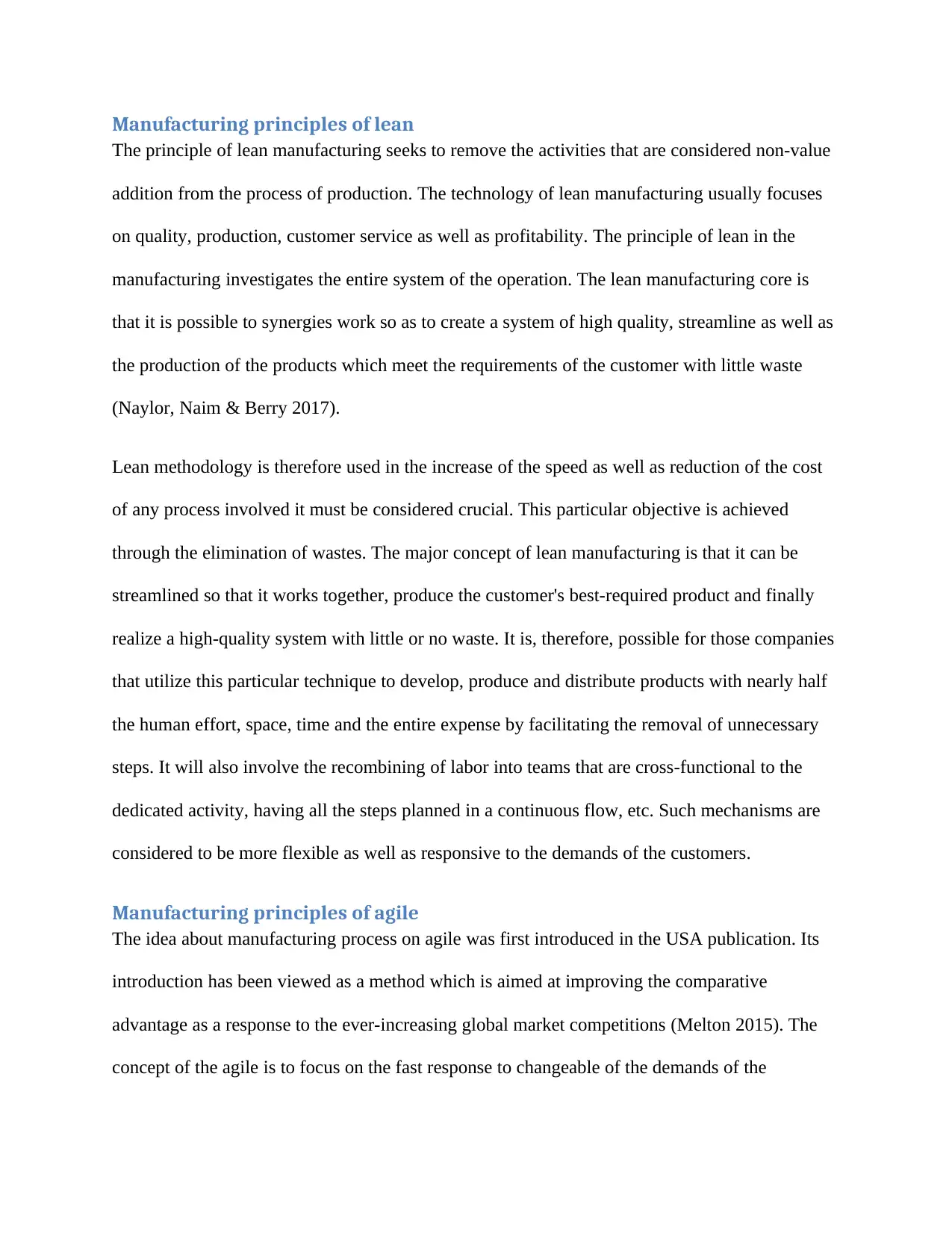
Manufacturing principles of lean
The principle of lean manufacturing seeks to remove the activities that are considered non-value
addition from the process of production. The technology of lean manufacturing usually focuses
on quality, production, customer service as well as profitability. The principle of lean in the
manufacturing investigates the entire system of the operation. The lean manufacturing core is
that it is possible to synergies work so as to create a system of high quality, streamline as well as
the production of the products which meet the requirements of the customer with little waste
(Naylor, Naim & Berry 2017).
Lean methodology is therefore used in the increase of the speed as well as reduction of the cost
of any process involved it must be considered crucial. This particular objective is achieved
through the elimination of wastes. The major concept of lean manufacturing is that it can be
streamlined so that it works together, produce the customer's best-required product and finally
realize a high-quality system with little or no waste. It is, therefore, possible for those companies
that utilize this particular technique to develop, produce and distribute products with nearly half
the human effort, space, time and the entire expense by facilitating the removal of unnecessary
steps. It will also involve the recombining of labor into teams that are cross-functional to the
dedicated activity, having all the steps planned in a continuous flow, etc. Such mechanisms are
considered to be more flexible as well as responsive to the demands of the customers.
Manufacturing principles of agile
The idea about manufacturing process on agile was first introduced in the USA publication. Its
introduction has been viewed as a method which is aimed at improving the comparative
advantage as a response to the ever-increasing global market competitions (Melton 2015). The
concept of the agile is to focus on the fast response to changeable of the demands of the
The principle of lean manufacturing seeks to remove the activities that are considered non-value
addition from the process of production. The technology of lean manufacturing usually focuses
on quality, production, customer service as well as profitability. The principle of lean in the
manufacturing investigates the entire system of the operation. The lean manufacturing core is
that it is possible to synergies work so as to create a system of high quality, streamline as well as
the production of the products which meet the requirements of the customer with little waste
(Naylor, Naim & Berry 2017).
Lean methodology is therefore used in the increase of the speed as well as reduction of the cost
of any process involved it must be considered crucial. This particular objective is achieved
through the elimination of wastes. The major concept of lean manufacturing is that it can be
streamlined so that it works together, produce the customer's best-required product and finally
realize a high-quality system with little or no waste. It is, therefore, possible for those companies
that utilize this particular technique to develop, produce and distribute products with nearly half
the human effort, space, time and the entire expense by facilitating the removal of unnecessary
steps. It will also involve the recombining of labor into teams that are cross-functional to the
dedicated activity, having all the steps planned in a continuous flow, etc. Such mechanisms are
considered to be more flexible as well as responsive to the demands of the customers.
Manufacturing principles of agile
The idea about manufacturing process on agile was first introduced in the USA publication. Its
introduction has been viewed as a method which is aimed at improving the comparative
advantage as a response to the ever-increasing global market competitions (Melton 2015). The
concept of the agile is to focus on the fast response to changeable of the demands of the
Paraphrase This Document
Need a fresh take? Get an instant paraphrase of this document with our AI Paraphraser
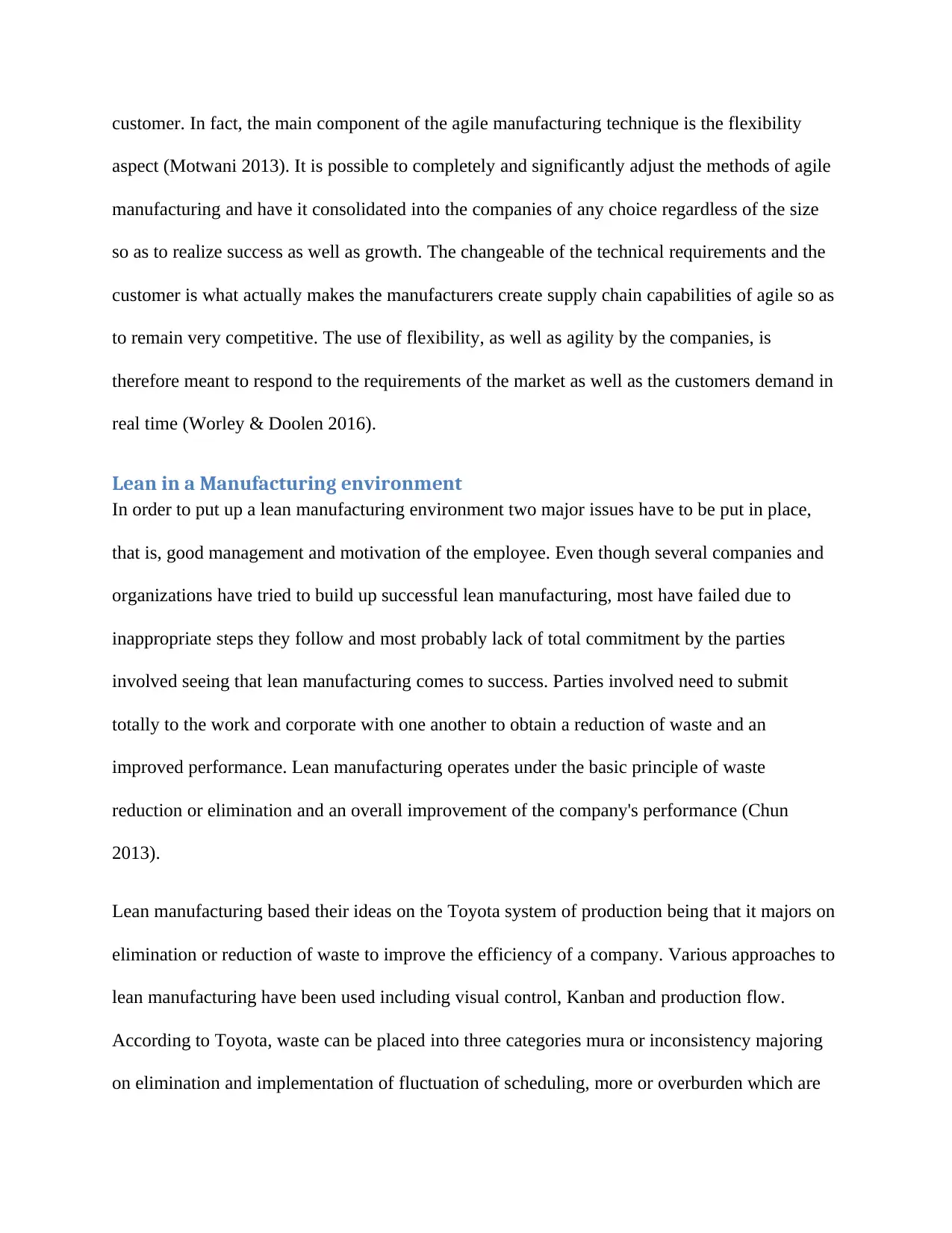
customer. In fact, the main component of the agile manufacturing technique is the flexibility
aspect (Motwani 2013). It is possible to completely and significantly adjust the methods of agile
manufacturing and have it consolidated into the companies of any choice regardless of the size
so as to realize success as well as growth. The changeable of the technical requirements and the
customer is what actually makes the manufacturers create supply chain capabilities of agile so as
to remain very competitive. The use of flexibility, as well as agility by the companies, is
therefore meant to respond to the requirements of the market as well as the customers demand in
real time (Worley & Doolen 2016).
Lean in a Manufacturing environment
In order to put up a lean manufacturing environment two major issues have to be put in place,
that is, good management and motivation of the employee. Even though several companies and
organizations have tried to build up successful lean manufacturing, most have failed due to
inappropriate steps they follow and most probably lack of total commitment by the parties
involved seeing that lean manufacturing comes to success. Parties involved need to submit
totally to the work and corporate with one another to obtain a reduction of waste and an
improved performance. Lean manufacturing operates under the basic principle of waste
reduction or elimination and an overall improvement of the company's performance (Chun
2013).
Lean manufacturing based their ideas on the Toyota system of production being that it majors on
elimination or reduction of waste to improve the efficiency of a company. Various approaches to
lean manufacturing have been used including visual control, Kanban and production flow.
According to Toyota, waste can be placed into three categories mura or inconsistency majoring
on elimination and implementation of fluctuation of scheduling, more or overburden which are
aspect (Motwani 2013). It is possible to completely and significantly adjust the methods of agile
manufacturing and have it consolidated into the companies of any choice regardless of the size
so as to realize success as well as growth. The changeable of the technical requirements and the
customer is what actually makes the manufacturers create supply chain capabilities of agile so as
to remain very competitive. The use of flexibility, as well as agility by the companies, is
therefore meant to respond to the requirements of the market as well as the customers demand in
real time (Worley & Doolen 2016).
Lean in a Manufacturing environment
In order to put up a lean manufacturing environment two major issues have to be put in place,
that is, good management and motivation of the employee. Even though several companies and
organizations have tried to build up successful lean manufacturing, most have failed due to
inappropriate steps they follow and most probably lack of total commitment by the parties
involved seeing that lean manufacturing comes to success. Parties involved need to submit
totally to the work and corporate with one another to obtain a reduction of waste and an
improved performance. Lean manufacturing operates under the basic principle of waste
reduction or elimination and an overall improvement of the company's performance (Chun
2013).
Lean manufacturing based their ideas on the Toyota system of production being that it majors on
elimination or reduction of waste to improve the efficiency of a company. Various approaches to
lean manufacturing have been used including visual control, Kanban and production flow.
According to Toyota, waste can be placed into three categories mura or inconsistency majoring
on elimination and implementation of fluctuation of scheduling, more or overburden which are
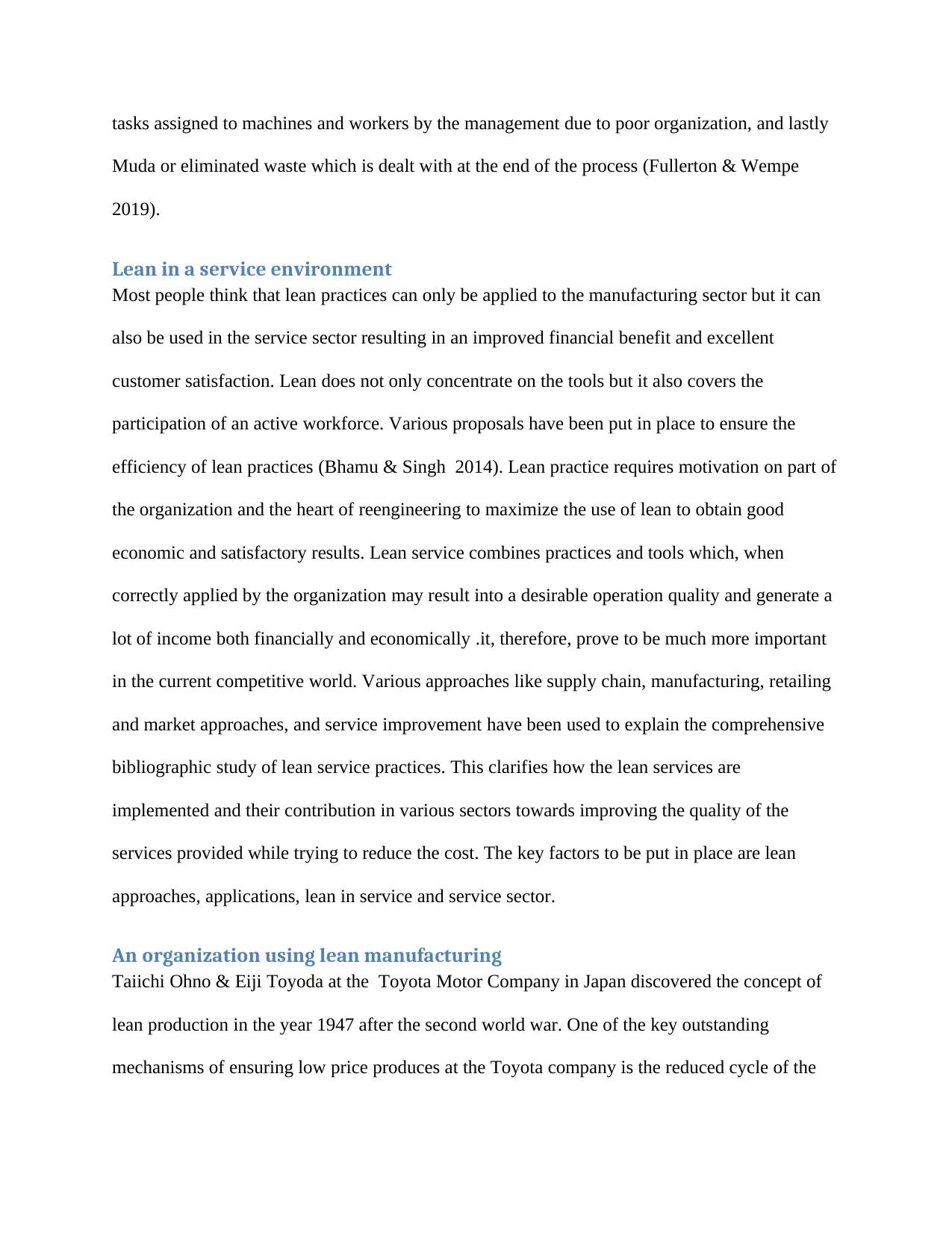
tasks assigned to machines and workers by the management due to poor organization, and lastly
Muda or eliminated waste which is dealt with at the end of the process (Fullerton & Wempe
2019).
Lean in a service environment
Most people think that lean practices can only be applied to the manufacturing sector but it can
also be used in the service sector resulting in an improved financial benefit and excellent
customer satisfaction. Lean does not only concentrate on the tools but it also covers the
participation of an active workforce. Various proposals have been put in place to ensure the
efficiency of lean practices (Bhamu & Singh 2014). Lean practice requires motivation on part of
the organization and the heart of reengineering to maximize the use of lean to obtain good
economic and satisfactory results. Lean service combines practices and tools which, when
correctly applied by the organization may result into a desirable operation quality and generate a
lot of income both financially and economically .it, therefore, prove to be much more important
in the current competitive world. Various approaches like supply chain, manufacturing, retailing
and market approaches, and service improvement have been used to explain the comprehensive
bibliographic study of lean service practices. This clarifies how the lean services are
implemented and their contribution in various sectors towards improving the quality of the
services provided while trying to reduce the cost. The key factors to be put in place are lean
approaches, applications, lean in service and service sector.
An organization using lean manufacturing
Taiichi Ohno & Eiji Toyoda at the Toyota Motor Company in Japan discovered the concept of
lean production in the year 1947 after the second world war. One of the key outstanding
mechanisms of ensuring low price produces at the Toyota company is the reduced cycle of the
Muda or eliminated waste which is dealt with at the end of the process (Fullerton & Wempe
2019).
Lean in a service environment
Most people think that lean practices can only be applied to the manufacturing sector but it can
also be used in the service sector resulting in an improved financial benefit and excellent
customer satisfaction. Lean does not only concentrate on the tools but it also covers the
participation of an active workforce. Various proposals have been put in place to ensure the
efficiency of lean practices (Bhamu & Singh 2014). Lean practice requires motivation on part of
the organization and the heart of reengineering to maximize the use of lean to obtain good
economic and satisfactory results. Lean service combines practices and tools which, when
correctly applied by the organization may result into a desirable operation quality and generate a
lot of income both financially and economically .it, therefore, prove to be much more important
in the current competitive world. Various approaches like supply chain, manufacturing, retailing
and market approaches, and service improvement have been used to explain the comprehensive
bibliographic study of lean service practices. This clarifies how the lean services are
implemented and their contribution in various sectors towards improving the quality of the
services provided while trying to reduce the cost. The key factors to be put in place are lean
approaches, applications, lean in service and service sector.
An organization using lean manufacturing
Taiichi Ohno & Eiji Toyoda at the Toyota Motor Company in Japan discovered the concept of
lean production in the year 1947 after the second world war. One of the key outstanding
mechanisms of ensuring low price produces at the Toyota company is the reduced cycle of the
⊘ This is a preview!⊘
Do you want full access?
Subscribe today to unlock all pages.

Trusted by 1+ million students worldwide
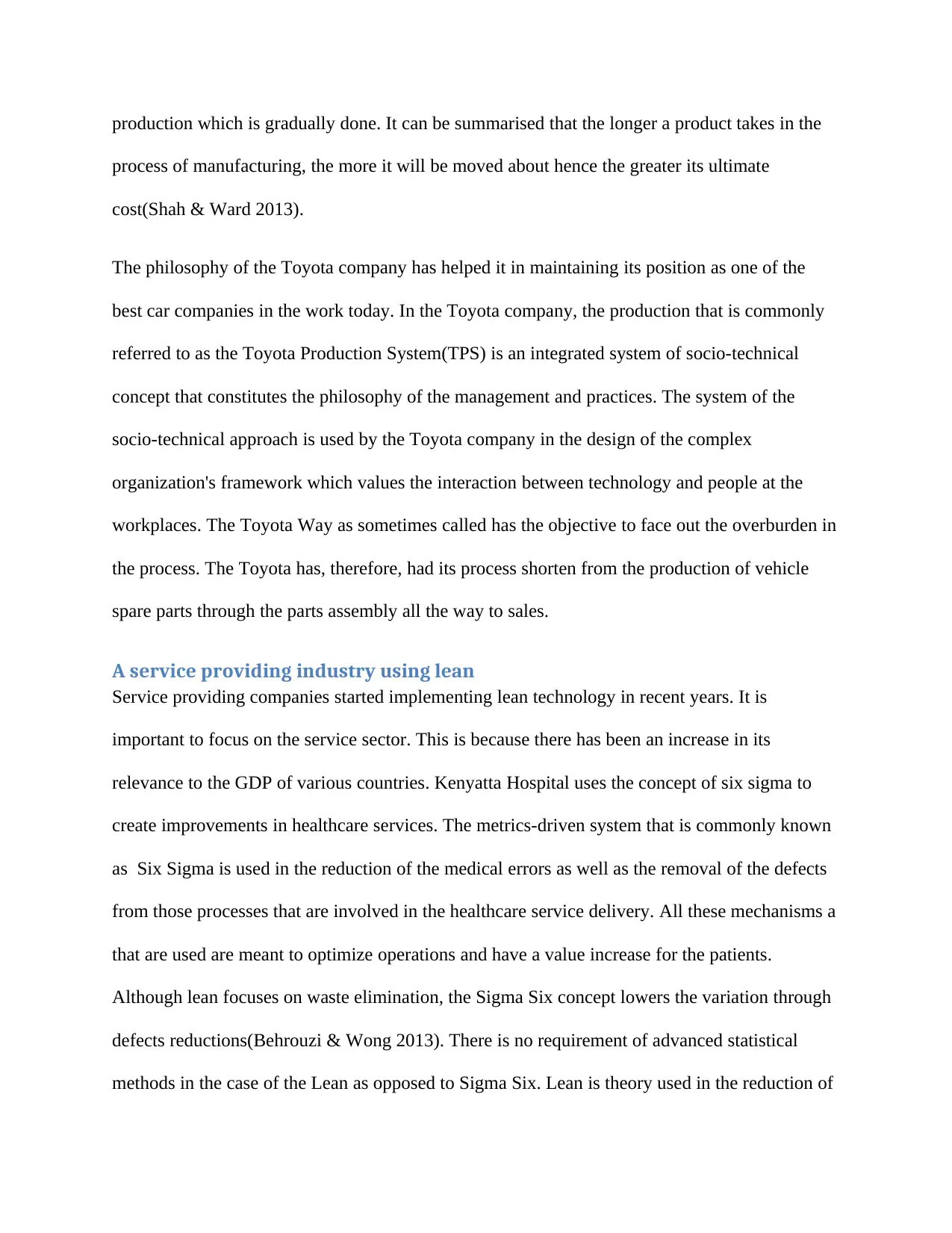
production which is gradually done. It can be summarised that the longer a product takes in the
process of manufacturing, the more it will be moved about hence the greater its ultimate
cost(Shah & Ward 2013).
The philosophy of the Toyota company has helped it in maintaining its position as one of the
best car companies in the work today. In the Toyota company, the production that is commonly
referred to as the Toyota Production System(TPS) is an integrated system of socio-technical
concept that constitutes the philosophy of the management and practices. The system of the
socio-technical approach is used by the Toyota company in the design of the complex
organization's framework which values the interaction between technology and people at the
workplaces. The Toyota Way as sometimes called has the objective to face out the overburden in
the process. The Toyota has, therefore, had its process shorten from the production of vehicle
spare parts through the parts assembly all the way to sales.
A service providing industry using lean
Service providing companies started implementing lean technology in recent years. It is
important to focus on the service sector. This is because there has been an increase in its
relevance to the GDP of various countries. Kenyatta Hospital uses the concept of six sigma to
create improvements in healthcare services. The metrics-driven system that is commonly known
as Six Sigma is used in the reduction of the medical errors as well as the removal of the defects
from those processes that are involved in the healthcare service delivery. All these mechanisms a
that are used are meant to optimize operations and have a value increase for the patients.
Although lean focuses on waste elimination, the Sigma Six concept lowers the variation through
defects reductions(Behrouzi & Wong 2013). There is no requirement of advanced statistical
methods in the case of the Lean as opposed to Sigma Six. Lean is theory used in the reduction of
process of manufacturing, the more it will be moved about hence the greater its ultimate
cost(Shah & Ward 2013).
The philosophy of the Toyota company has helped it in maintaining its position as one of the
best car companies in the work today. In the Toyota company, the production that is commonly
referred to as the Toyota Production System(TPS) is an integrated system of socio-technical
concept that constitutes the philosophy of the management and practices. The system of the
socio-technical approach is used by the Toyota company in the design of the complex
organization's framework which values the interaction between technology and people at the
workplaces. The Toyota Way as sometimes called has the objective to face out the overburden in
the process. The Toyota has, therefore, had its process shorten from the production of vehicle
spare parts through the parts assembly all the way to sales.
A service providing industry using lean
Service providing companies started implementing lean technology in recent years. It is
important to focus on the service sector. This is because there has been an increase in its
relevance to the GDP of various countries. Kenyatta Hospital uses the concept of six sigma to
create improvements in healthcare services. The metrics-driven system that is commonly known
as Six Sigma is used in the reduction of the medical errors as well as the removal of the defects
from those processes that are involved in the healthcare service delivery. All these mechanisms a
that are used are meant to optimize operations and have a value increase for the patients.
Although lean focuses on waste elimination, the Sigma Six concept lowers the variation through
defects reductions(Behrouzi & Wong 2013). There is no requirement of advanced statistical
methods in the case of the Lean as opposed to Sigma Six. Lean is theory used in the reduction of
Paraphrase This Document
Need a fresh take? Get an instant paraphrase of this document with our AI Paraphraser
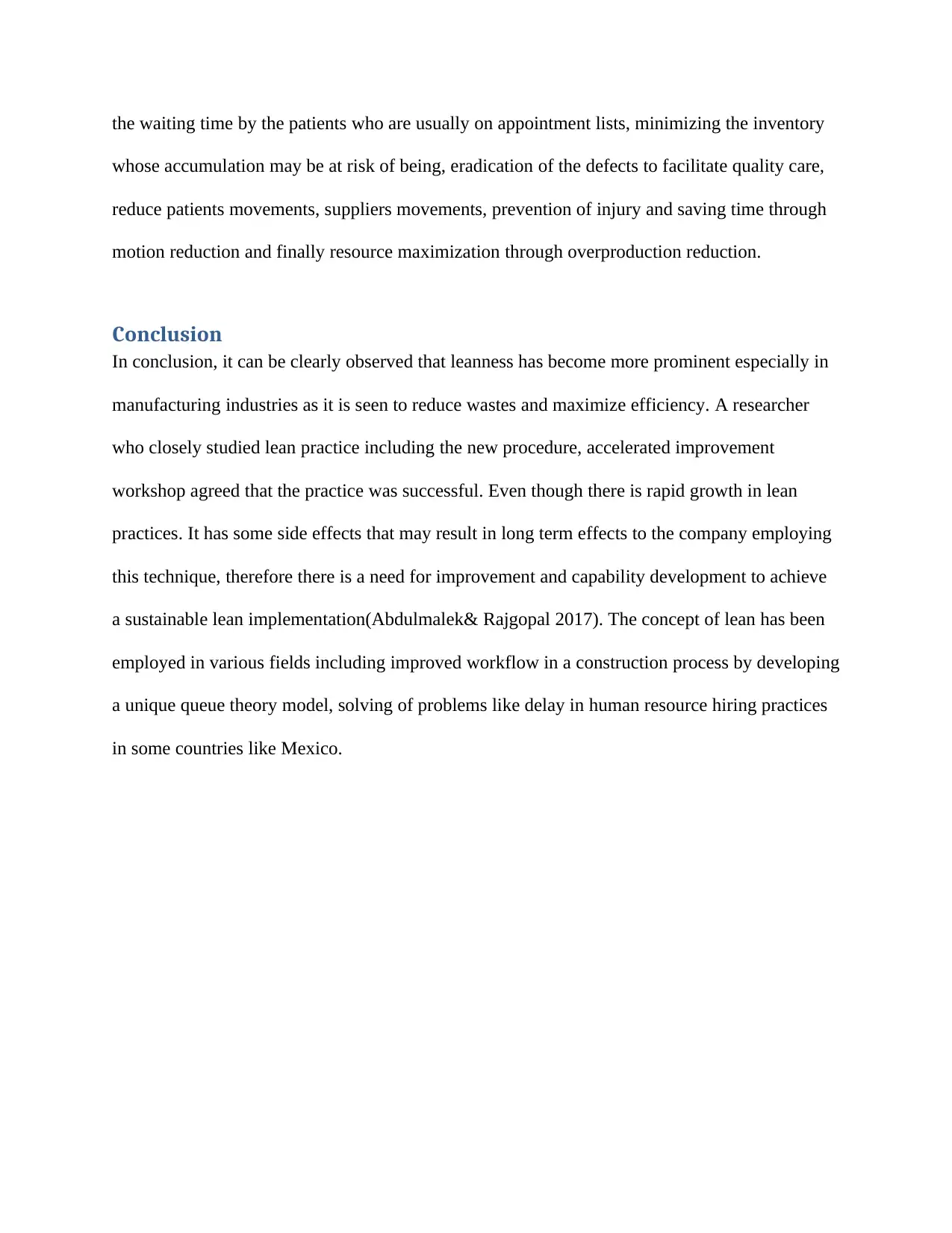
the waiting time by the patients who are usually on appointment lists, minimizing the inventory
whose accumulation may be at risk of being, eradication of the defects to facilitate quality care,
reduce patients movements, suppliers movements, prevention of injury and saving time through
motion reduction and finally resource maximization through overproduction reduction.
Conclusion
In conclusion, it can be clearly observed that leanness has become more prominent especially in
manufacturing industries as it is seen to reduce wastes and maximize efficiency. A researcher
who closely studied lean practice including the new procedure, accelerated improvement
workshop agreed that the practice was successful. Even though there is rapid growth in lean
practices. It has some side effects that may result in long term effects to the company employing
this technique, therefore there is a need for improvement and capability development to achieve
a sustainable lean implementation(Abdulmalek& Rajgopal 2017). The concept of lean has been
employed in various fields including improved workflow in a construction process by developing
a unique queue theory model, solving of problems like delay in human resource hiring practices
in some countries like Mexico.
whose accumulation may be at risk of being, eradication of the defects to facilitate quality care,
reduce patients movements, suppliers movements, prevention of injury and saving time through
motion reduction and finally resource maximization through overproduction reduction.
Conclusion
In conclusion, it can be clearly observed that leanness has become more prominent especially in
manufacturing industries as it is seen to reduce wastes and maximize efficiency. A researcher
who closely studied lean practice including the new procedure, accelerated improvement
workshop agreed that the practice was successful. Even though there is rapid growth in lean
practices. It has some side effects that may result in long term effects to the company employing
this technique, therefore there is a need for improvement and capability development to achieve
a sustainable lean implementation(Abdulmalek& Rajgopal 2017). The concept of lean has been
employed in various fields including improved workflow in a construction process by developing
a unique queue theory model, solving of problems like delay in human resource hiring practices
in some countries like Mexico.
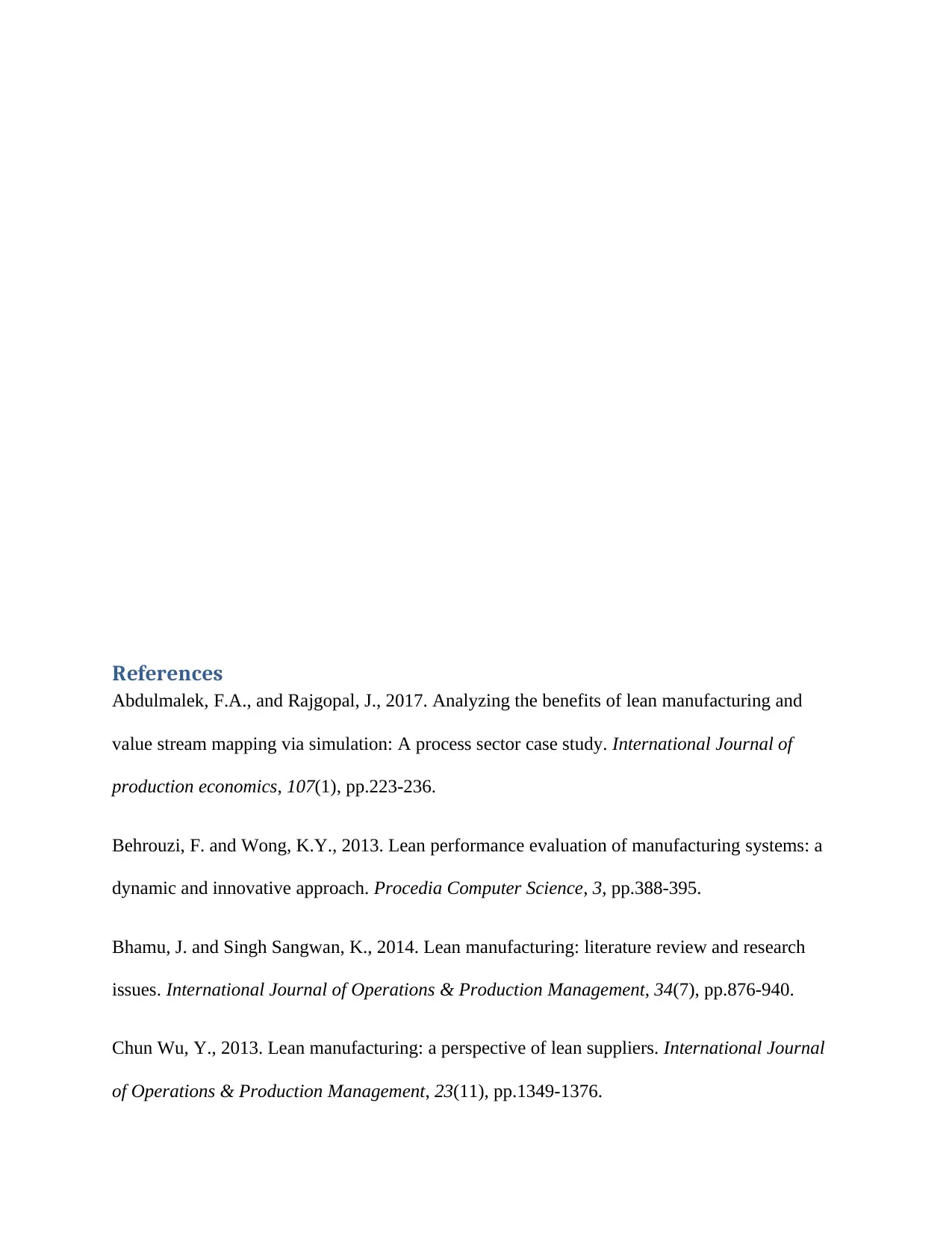
References
Abdulmalek, F.A., and Rajgopal, J., 2017. Analyzing the benefits of lean manufacturing and
value stream mapping via simulation: A process sector case study. International Journal of
production economics, 107(1), pp.223-236.
Behrouzi, F. and Wong, K.Y., 2013. Lean performance evaluation of manufacturing systems: a
dynamic and innovative approach. Procedia Computer Science, 3, pp.388-395.
Bhamu, J. and Singh Sangwan, K., 2014. Lean manufacturing: literature review and research
issues. International Journal of Operations & Production Management, 34(7), pp.876-940.
Chun Wu, Y., 2013. Lean manufacturing: a perspective of lean suppliers. International Journal
of Operations & Production Management, 23(11), pp.1349-1376.
Abdulmalek, F.A., and Rajgopal, J., 2017. Analyzing the benefits of lean manufacturing and
value stream mapping via simulation: A process sector case study. International Journal of
production economics, 107(1), pp.223-236.
Behrouzi, F. and Wong, K.Y., 2013. Lean performance evaluation of manufacturing systems: a
dynamic and innovative approach. Procedia Computer Science, 3, pp.388-395.
Bhamu, J. and Singh Sangwan, K., 2014. Lean manufacturing: literature review and research
issues. International Journal of Operations & Production Management, 34(7), pp.876-940.
Chun Wu, Y., 2013. Lean manufacturing: a perspective of lean suppliers. International Journal
of Operations & Production Management, 23(11), pp.1349-1376.
⊘ This is a preview!⊘
Do you want full access?
Subscribe today to unlock all pages.

Trusted by 1+ million students worldwide
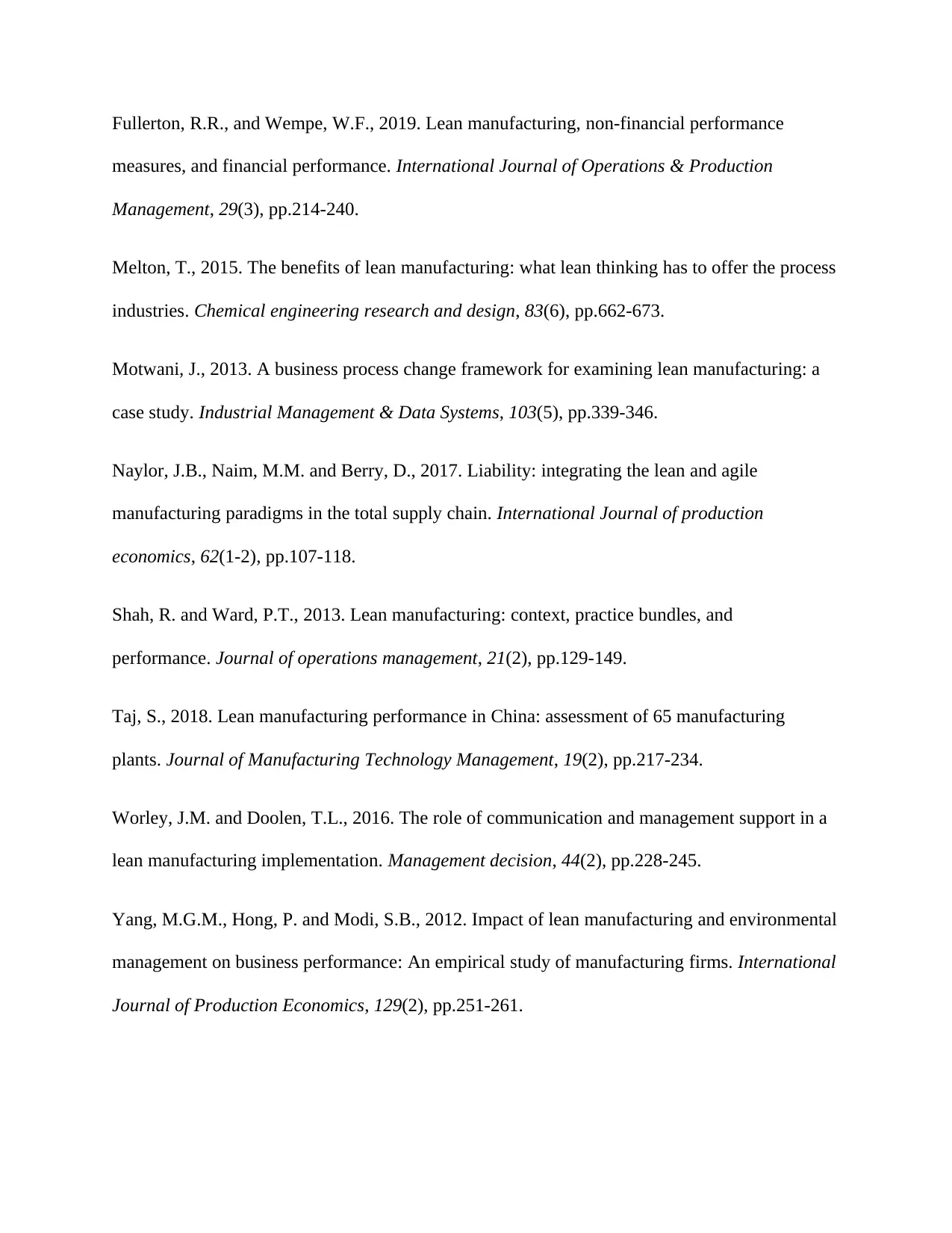
Fullerton, R.R., and Wempe, W.F., 2019. Lean manufacturing, non-financial performance
measures, and financial performance. International Journal of Operations & Production
Management, 29(3), pp.214-240.
Melton, T., 2015. The benefits of lean manufacturing: what lean thinking has to offer the process
industries. Chemical engineering research and design, 83(6), pp.662-673.
Motwani, J., 2013. A business process change framework for examining lean manufacturing: a
case study. Industrial Management & Data Systems, 103(5), pp.339-346.
Naylor, J.B., Naim, M.M. and Berry, D., 2017. Liability: integrating the lean and agile
manufacturing paradigms in the total supply chain. International Journal of production
economics, 62(1-2), pp.107-118.
Shah, R. and Ward, P.T., 2013. Lean manufacturing: context, practice bundles, and
performance. Journal of operations management, 21(2), pp.129-149.
Taj, S., 2018. Lean manufacturing performance in China: assessment of 65 manufacturing
plants. Journal of Manufacturing Technology Management, 19(2), pp.217-234.
Worley, J.M. and Doolen, T.L., 2016. The role of communication and management support in a
lean manufacturing implementation. Management decision, 44(2), pp.228-245.
Yang, M.G.M., Hong, P. and Modi, S.B., 2012. Impact of lean manufacturing and environmental
management on business performance: An empirical study of manufacturing firms. International
Journal of Production Economics, 129(2), pp.251-261.
measures, and financial performance. International Journal of Operations & Production
Management, 29(3), pp.214-240.
Melton, T., 2015. The benefits of lean manufacturing: what lean thinking has to offer the process
industries. Chemical engineering research and design, 83(6), pp.662-673.
Motwani, J., 2013. A business process change framework for examining lean manufacturing: a
case study. Industrial Management & Data Systems, 103(5), pp.339-346.
Naylor, J.B., Naim, M.M. and Berry, D., 2017. Liability: integrating the lean and agile
manufacturing paradigms in the total supply chain. International Journal of production
economics, 62(1-2), pp.107-118.
Shah, R. and Ward, P.T., 2013. Lean manufacturing: context, practice bundles, and
performance. Journal of operations management, 21(2), pp.129-149.
Taj, S., 2018. Lean manufacturing performance in China: assessment of 65 manufacturing
plants. Journal of Manufacturing Technology Management, 19(2), pp.217-234.
Worley, J.M. and Doolen, T.L., 2016. The role of communication and management support in a
lean manufacturing implementation. Management decision, 44(2), pp.228-245.
Yang, M.G.M., Hong, P. and Modi, S.B., 2012. Impact of lean manufacturing and environmental
management on business performance: An empirical study of manufacturing firms. International
Journal of Production Economics, 129(2), pp.251-261.
Paraphrase This Document
Need a fresh take? Get an instant paraphrase of this document with our AI Paraphraser

1 out of 11
Related Documents
Your All-in-One AI-Powered Toolkit for Academic Success.
+13062052269
info@desklib.com
Available 24*7 on WhatsApp / Email
![[object Object]](/_next/static/media/star-bottom.7253800d.svg)
Unlock your academic potential
Copyright © 2020–2025 A2Z Services. All Rights Reserved. Developed and managed by ZUCOL.




